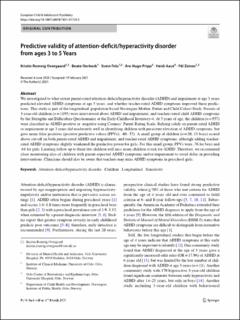| dc.contributor.author | Øvergaard, Kristin Romvig | |
| dc.contributor.author | Ørbeck, Beate | |
| dc.contributor.author | Friis, Svein | |
| dc.contributor.author | Pripp, Are Hugo | |
| dc.contributor.author | Aase, Heidi | |
| dc.contributor.author | Zeiner, Pål | |
| dc.date.accessioned | 2022-02-22T07:14:22Z | |
| dc.date.available | 2022-02-22T07:14:22Z | |
| dc.date.created | 2021-03-08T06:48:03Z | |
| dc.date.issued | 2021 | |
| dc.identifier.citation | European Child and Adolescent Psychiatry. 2021, . | |
| dc.identifier.issn | 1018-8827 | |
| dc.identifier.uri | https://hdl.handle.net/11250/2980662 | |
| dc.description.abstract | We investigated to what extent parent-rated attention-deficit/hyperactivity disorder (ADHD) and impairment at age 3 years predicted elevated ADHD symptoms at age 5 years, and whether teacher-rated ADHD symptoms improved these predictions. This study is part of the longitudinal, population-based Norwegian Mother, Father and Child Cohort Study. Parents of 3-year-old children (n = 1195) were interviewed about ADHD and impairment, and teachers rated child ADHD symptoms by the Strengths and Difficulties Questionnaire or the Early Childhood Inventory-4. At 5 years of age, the children (n = 957) were classified as ADHD-positive or -negative using Conners’ Parent Rating Scale. Relying solely on parent-rated ADHD or impairment at age 3 years did moderately well in identifying children with persistent elevation of ADHD symptoms, but gave many false positives (positive predictive values (PPVs): .40–.57). A small group of children (n = 20, 13 boys) scored above cut-off on both parent-rated ADHD and impairment, and teacher-rated ADHD symptoms, although adding teacher-rated ADHD symptoms slightly weakened the predictive power for girls. For this small group, PPVs were .76 for boys and .64 for girls. Limiting follow-up to these few children will miss many children at risk for ADHD. Therefore, we recommend close monitoring also of children with parent-reported ADHD symptoms and/or impairment to avoid delay in providing interventions. Clinicians should also be aware that teachers may miss ADHD symptoms in preschool girls. | |
| dc.language.iso | eng | |
| dc.subject | Sensitivitet | |
| dc.subject | Ecological sensitivity | |
| dc.subject | Barn | |
| dc.subject | Children | |
| dc.subject | ADHD | |
| dc.subject | ADHD | |
| dc.subject | Longitudinell studie | |
| dc.subject | Cohort study | |
| dc.title | Predictive validity of attention-deficit/hyperactivity disorder from ages 3 to 5 Years | |
| dc.type | Peer reviewed | |
| dc.type | Journal article | |
| dc.description.version | publishedVersion | |
| dc.source.pagenumber | 10 | |
| dc.source.journal | European Child and Adolescent Psychiatry | |
| dc.identifier.doi | 10.1007/s00787-021-01750-5 | |
| dc.identifier.cristin | 1896215 | |
| cristin.ispublished | true | |
| cristin.fulltext | original | |
| cristin.qualitycode | 2 | |
